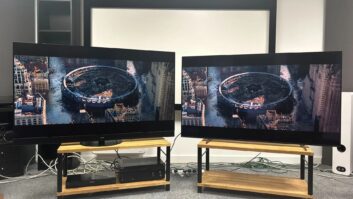Secaucus, N.J. – Panasonic introduced a number of camcorders on
Tuesday, including a 3D camcorder and a pair of FullHD models.
The company also announced a digital interchangeable twin lens
that makes it possible to shoot 3D with an interchangeable-lens-system camera
The HDC-SDT750 3D camcorder comes with a 3D-conversion lens that
needs to be attached to shoot 3D video. According to Panasonic, the 3D-conversion
lens records right-eye and left-eye images simultaneously through its two
lenses, thus resulting in video that can be viewed in 3D. The right and left
images (each with 960 by 1080 pixels) that enter through the lenses are
recorded using the side-by-side method.
The HDC-3DT750 can also record full 1080p HD in AVCHD and boasts
a 3MOS system, a Leica Dicomar lens and a 12x optical zoom.
Other features include a Time Lapse Recording feature; a
5.1-channel audio-recording sound system that uses five microphones; a manual
ring that enables fingertip control of the focus, zoom, exposure, shutter speed
and white-balance settings; and the company’s Intelligent Auto function that’s
designed to automatically select the most suitable shooting mode.
It also has a 3-inch touchscreen LCD. Suggested retail is $1,399.
The HDC-SDT750 will be available in October.
As part of Panasonic’s compact camcorder offerings, the HDC-SDX1 ($500
suggested retail) features horizontal design styling with a side-mounted
flip-out 2.7-inch (230,400-dot) widescreen LCD monitor, up to 1080/30fps FullHD
video recording in AVCHD format, and up to 2.9-megapixel still resolution. It
also has an SD card slot with support for SDXC expanded capacity cards, 3.32-megapixel
MOS sensor, 16.8x optical zoom lens (35.8-716mm 35mm film equivalent), up to
23x digital zoom, and a hybrid optical image stabilization system.
It offers simultaneous shooting of video and still images and the
ability to grab still frames out of recorded video sequences.
Addressing the fastest-growing segment of the low-end camcorder
market, Panasonic introduced the HM-TA1 pocket camcorder. The company bills the
unit as a “Shoot & Share” camcorder, playing up the product’s ability to
easily shoot stills and video and quickly upload the results to friends and
family via email and various social-networking sites, including Facebook and
YouTube.
The camcorder was also designed to work as a webcam for use with
Skype video conferencing, and comes pre-installed with supporting software for
that function. It will support Pansonic’s new Skype TVs, but only with SD
resolution.
The TA1 has a candy-bar-design style, a built-in 2-inch
153,600-dot LCD monitor, a 4x digital zoom and a MOS sensor. It will produce up
to FullHD 1080p/30 fps video resolution and 8-megapixel stills (plus up to
5-megapixel still-frame grabs out of video sequences).
In addition, the camcorder supports the Apple iFrame standard,
which is a constraint of the H.264 codec developed to ensure ease of consumer
video editing.
iFrame specifies a 540p/30 parameter that is one-half the spatial
resolution of 1080p in each direction, one-quarter the total number of pixels. However,
the progressive scanning allows for a higher-quality image than conventional
standard-definition sources.
The reduced file size of the iFrame system is said to make it
easier and quicker to share videos, particularly with Mac users. The iFrame
format is supported by iMovie software on Apple computers.
To play up the expanded Apple compatibility of the camcorder,
Apple will be demonstrating the camcorder in Apple stores, said Christopher
Rice, Panasonic camcorders senior product manager. The TA1 will also be sold
through Apple.com as well as Amazon and other online e-commerce sites.
For enhanced indoor or night-time shooting, the TA1 includes a
built-in LED light to capture images in the camera’s field of view under dimly
lit conditions.
Also included is a built-in USB connector and A/V output, however
no HDMI port is included.
In explaining the omission, Panasonic cited research showing that
only about 5 percent of pocket-style camcorder users connect their cameras to
TVs for playback, opting instead to view images on PCs, from DVDs and on the
camcorder screen itself.
Finally, the digital interchangeable twin-lens announced by
Panasonic is engineered to lets users shoot 3D with an
interchangeable-lens-system camera. According to a company spokesperson, a
model number has not yet been determined, but an announcement from Panasonic
indicated it would be part of the Lumix G Micro System lineup.
The lens has two optical systems installed within the diameter of
the lens mount, creating stereo images from the left and right lenses that are
then processed with a 3D image processing system, Panasonic said, adding that
they compact lens will “allow instant 3D shooting, without distortion or time
lag between left and right images — even when shooting moving objects.”
Pricing and availability weren’t given, although the spokesperson
said the lens would be available this year.













